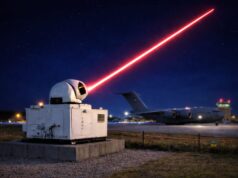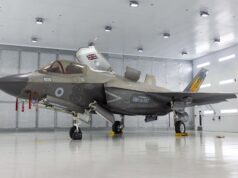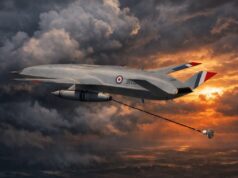In a parliamentary exchange on 18 November 2024, Defence Procurement and Industry Minister Maria Eagle outlined the UK’s role in enhancing NATO missile defence capabilities.
Speaking in response to questions from MPs, Eagle spoke of the UK’s commitment to modernising air and missile defence systems both nationally and in collaboration with NATO allies, describing missile defence as “a cross-Government and international effort.”
Labour MP Lucy Rigby, representing Northampton North, asked about the Government’s recent actions on missile defence cooperation with NATO. Rigby highlighted discussions during last month’s NATO Defence Ministers’ meeting, where the UK agreed to step up collaboration on missile defence and advanced long-range missile systems.
She stressed the importance of integrating NATO missile defence systems, stating: “Does the Minister agree that a focus on integrating NATO’s missile defence is key to strengthening European security?”
Eagle agreed, underscoring the critical role of integration in ensuring security across the alliance:
“Defence against air and missile threats has played a key role in our recent thinking, and with our NATO-first approach to policy, putting integration with our allies at the heart of our defence plans makes sense and is a vital part of ensuring our security going forward.”
Sir Roger Gale, Conservative MP for Herne Bay and Sandwich, raised the issue of Ukraine’s use of missile defence systems supplied by NATO members. He questioned whether the UK would support Ukraine in deploying these systems independently, in coordination with NATO or bilaterally with the United States.
Gale asked: “Will the United Kingdom, preferably in tandem with our European colleagues but if necessary bilaterally with the United States, align with the United States in permitting Ukraine to use the missile defence systems that we have supplied as it sees fit in its own defence?”
In her response, Eagle confirmed the UK’s alignment with its allies in ensuring Ukraine can utilise the missile defence capabilities provided, saying: “Absolutely. We intend to align with our allies in making sure that Ukraine can make use of the capability that has been offered by those who have committed support to that country in its fight.”
The UK remains a key player in NATO’s missile defence strategy, say the Government, focusing on integration, modernisation, and support for allied nations like Ukraine.
Eagle reiterated the Government’s commitment, stating: “This Government are getting on with delivering for defence to make Britain secure at home and strong abroad. The UK remains a leading voice in NATO on missile defence.”
At the UK Defence Journal, we aim to deliver accurate and timely news on defence matters. We rely on the support of readers like you to maintain our independence and high-quality journalism. Please consider making a one-off donation to help us continue our work. Click here to donate. Thank you for your support!














We are currently part of three missile defence initiatives for Europe and apparently developing not one but two long range cruise missiles and a hypersonic missile.
The UK keeps announcing shit like this but never actually does anything.
It’s becoming like our drones.
Yeah Jim we seem to announce a lot!! But you never seem to see much progress unfortunately.
Yep! The United Kingdom, fitted for, just not supplied with. That’s a catching virus from the Royal Navy.
😁🤔😳☹️👍
To me, the logically way for the UK to achieve this is to procure more air defence destroyers. The first Type 83 could be in addition to, rather than replacements for, Type 45s – thereby growing the number of destroyers. They could be used to protect the UK, but when required could also deploy elsewhere (flexibility and not fixed targets).
Given the timescales to bring the 83 into existence that seems rather a long wait.
Taking into account-
* the cost of a modern destroyer
* its 6/7 year build schedule
the better option is land based systems. Quicker into service and far more affordable.
Or, perhaps better still, accelerate the development of long range conventionally armed missiles and rely more on deterrence than interception. Or both😃
Bit of both would be lovely.
Destroyers cost many times more than a GBAD and take decades to procure.
One Patriot battery costs around £800m. Type 83 is likely to be more, but not many times more. Fair point about the length of time to procure destroyers though.
Yes but SAMP/T is about half that cost. A repeat T45 today would easily cost £1.5 billi9n so roughly three times the cost of a SAMP/T battery.
Yes Jim, SAMP/T is a logical choice, as with France and Italy and having hared inventories, systems with the Navy, nothing really wasted. Is anything happening with Sky Sabre or has it been parked somewhere down in the back carpark somewhere?
how many missiles does that 800m come with? thats the biggest expense. thats also not factored into the cost of the ship but easily hundreds of millions if including reloads.
Why go to the expense of a ship to defend the UK mainland? It defies all logic! Not to mention deprives the fleet of what is supposed to be a naval asset.
The USN operate 5 destroyers out of Rota. One of their missions is missile defence within the European theatre. Why, especially as an island nation, does it defy logic that we do the same? After all, any missiles aimed at the UK have to cross the sea. Land based systems are great for countries like Poland who have no sea between them and the threat, but more destroyers (if they can be built fast enough) makes more sense for us. If we went down the land based system route, that would mean a whole lot of extra burden on the Army (possibly the RAF) who would have to train the people and develop the capability from scratch (whereas the RN already do missile defence).
Better to shoot them down over the North sea using the destroyers than waiting for land based systems.. also having destroyers can be positioned anywhere in the world when the UK isn’t under threat.
Yes it defies logic, these ships are primarily there as an interim capability until land based facilities were completed. You will see them withdrawn fairly soon.
I agree with you in general, it’s just the time to get a decent number of highly capable air and ballistic missile defence destroyers into service that’s the problem. As we stand land based would be quicker and depending on platform choice cheaper. Longer term ship based should be the prime or certainly additional platform for this role.
if you’re defending an inland base- are the missiles coming from the north? the west? etc. you’d need multiple destroyers to cover all vectors along with the cost of running a ship 24/7/365. or 1 strategically based ground asset to protect a base or city depending on missiles carried. honestly the UK seems like the perfect place for something like AEGIS ashore with SM-3, 2 and 6.
Perhaps we should ask our new friends the Japanese as it’s the strategy they have changed to.
It does not, sometimes the best interception position is in the ocean. It also protects the asset.
As far as know UK has zero defence against Russian MRBMs, totally dependent US siting THAAD and Patriot systems, the Type 45 Aster 30 BI only capable of defending against 800 km SRBMs, whereas Germany awarded IAI $3.5 billion contract Sep 2023 for their Arrow 3 high-altitude defense system with first deployment 2025.
https://breakingdefense.com/2024/11/amid-its-own-war-israel-to-send-arrow-3-air-defenses-to-germany-in-2025/
Lots of waffle and little action! First thing to do is increase the absolute inadequate numbers of GBAD platforms for our manoeuvre organisations, get the RAF Reg back to RAF airfield AD and stop pretending to be SF, and think about ER missiles for both! But the list of essential priorities for our military is long and now I believe to far gone to fix!
Pretty much this mate.
They talk, and talk, and talk.
And Grandstand. And Grandstand. And Grandstand.
BUY SOMETHING. COMMIT.
Indeed a good list.
I think 2 squadron would argue they don’t pretend.
It is one of Airborne’s “things” what with his Son in Law being a Rock Ape.
They even provide a JFAC Det and a Platoon (?) to SFSG.
How can we upgrade a capability we’ve not had for a very long while?
God I wish politicians would stop talking and do something. Air Defence UK is near non existant. Yet we could have a good air defence with existing technology that we already use. With six fire batteries each with 4-6 launchers of eight cells per launcher for Aster/SAMP-T and 9-12 fire batteries of CAAM CAAM-ER each battery of six launchers the complete UK would be covered. Our bases such as Lossie and RNMB Clyde would be protected, Yeovilton, Plymouth and Portmouth protected. To protected the AD fire batteries we could use the Sky Ranger 30 or 35, four guns per fire battery. These fire units should come under the control of the RAF Regt. This combined with four squadrons of interceptor/fighter aircraft would give the RAF complete control of the skies out to 200 miles from the UK. The missile system as the interceptor squadrons would take command and control from the ASACS such as the E-7s, Fylingdale and the remote radar heads.
It is only a suggestion, I have tried to use tech that we know; by doing this we could share between the Navy, Army and RAF missile stocks and I have tried to reduce the dependence on none UK/European supplies. I have also looked at mobile systems that can intergrate into the UKs fixed radar system but capable to support overseas deployment if needed, e.g. Iceland/Norway/Faroe Isles/Shetlands. By placing four fire batteries of SAMP-T on each of these locations at the shortest points we could or would have a complete air barrier if the Aster 1NT was used, well there could be a 30 km gap between the Faroes and the Shetlands. However, a further barriery of SAMP-T on Orkney would fix that issue. If we looked at air defence UK and air defence NATO it would mean that the UK might need 12 fire battieries of four launchers for Aster 1NT plus one launcher for Aster 15, 18 fire batteries of CAAM/CAAM-ER and 24 batteries of Sky Ranger, the job of the Sky Ranger is point defence for missile launch batteries.
This would mean about an extra 12 Regts for the Air Defence network for the UK and the Iceland-UK-Norway barrier.
This would cost money and people will say no we can’t or don’t have, yet I am going to give you what I would do if I was Russia and thinking about a strike against NATO. I would build up forces around St.Peterburg and locate two Corps in Belarus, this would get the attenetion of NATO, then stand them down. Whilst that is going on quitly put to sea four SSGNs about 500 km of the UK Atlantic coast and then launch missiles against Flyingdale, Lossie, RNMB Clyde and targets of choice but Plymouth and Brest would be an idea. The UK would be out of the fight before it started and the Atlantic would be open to Russian SSNs. That is what could happen if the UK government does not do something about the air defence of the nation. The Iceland-Faroe-Shetland-Norway barrier could be funded by NATO.
Again only a idea.